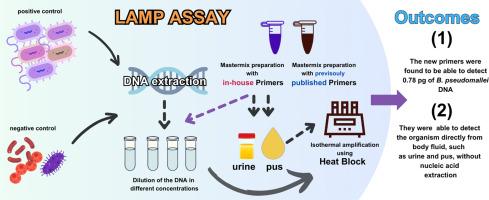An improved loop mediated isothermal amplification based assay for the rapid identification of genomic DNA of Burkholderia pseudomallei
IF 5.8
Q1 MICROBIOLOGY
引用次数: 0
Abstract
Burkholderia pseudomallei, the causative agent of the potentially life-threatening infectious disease, melioidosis, is endemic in Bangladesh. The spatial clustering of clinical incidence and the fatal outcome of melioidosis necessitates unequivocal and rapid detection and identification. Culture constitutes the gold standard test for the diagnosis of melioidosis, but identification of B. pseudomallei by culture is time consuming. In the view of the above, the present study has been designed to develop a Loop Mediated Isothermal Amplification based assay (LAMP) for the rapid and accurate detection of B. pseudomallei.
Twenty-two culture confirmed B. pseudomallei isolates and 18 non B. pseudomallei bacterial species were included in the study. DNA were extracted and amplified by in-house LAMP assay, utilizing a set of newly designed primers at optimized conditions. The LAMP product was visualized by various methods. The limit of detection (LOD) of LAMP was determined and detection of B. pseudomallei directly from sterile pre-inoculated urine by the LAMP technique was evaluated.
All 22 B pseudomallei were positive by the in-house LAMP while the 18 heterogeneous bacterial species were LAMP negative. The target sequence amplified by the LAMP outer primers showed the highest similarity with B. pseudomallei isolate UKMH10, confirming the specificity of the newly designed primers. The LOD of the in-house LAMP assay was found to be 0.78 pg, which is much lower than the LOD of PCR (0.78 ng). The in-house LAMP was also found positive for B. pseudomallei using direct sample such as pus and pre-inoculated urine. A closed tube LAMP assay using agar dye capsule was adopted to minimize contamination with LAMP amplification product and thus to increase the overall precision of the test.
Rapid and accurate detection of B. pseudomallei was developed using LAMP-based assay with a set of in-house designed primers. This detection procedure can be established for a cost-effective diagnosis of melioidosis at the rural level.

改进的环介导等温扩增法快速鉴定假马利氏伯克氏菌基因组DNA
假性伯克霍尔德菌是潜在威胁生命的类鼻疽病的病原体,在孟加拉国流行。临床发病率和致命结果的空间聚类需要明确和快速的检测和识别。培养是诊断类鼻疽病的金标准试验,但通过培养鉴定假芽孢杆菌是费时的。鉴于上述情况,本研究旨在建立基于环介导等温扩增(LAMP)的快速准确检测假芽孢杆菌的方法。共分离22株假芽孢杆菌和18株非假芽孢杆菌。利用一套新设计的引物,在优化的条件下,用LAMP法提取和扩增DNA。采用多种方法对LAMP产物进行可视化观察。测定了LAMP的检出限(LOD),并评价了LAMP技术直接从无菌预接种尿液中检出假芽孢杆菌的情况。22株假芽孢杆菌均为LAMP阳性,18株异种菌均为LAMP阴性。LAMP外部引物扩增的目标序列与假假芽孢杆菌分离物UKMH10的相似性最高,证实了新设计引物的特异性。LAMP检测的LOD为0.78 pg,远低于PCR检测的LOD (0.78 ng)。使用脓液和预接种的尿液等直接样本,室内LAMP也发现假芽孢杆菌阳性。采用琼脂染色胶囊封闭管LAMP实验,以尽量减少LAMP扩增产物的污染,从而提高测试的整体精度。采用lamp法和一套自行设计的引物,快速、准确地检测假芽孢杆菌。这一检测程序可用于在农村一级对类鼻疽病进行具有成本效益的诊断。
本文章由计算机程序翻译,如有差异,请以英文原文为准。
求助全文
约1分钟内获得全文
求助全文
来源期刊

Current Research in Microbial Sciences
Immunology and Microbiology-Immunology and Microbiology (miscellaneous)
CiteScore
7.90
自引率
0.00%
发文量
81
审稿时长
66 days
 求助内容:
求助内容: 应助结果提醒方式:
应助结果提醒方式:


